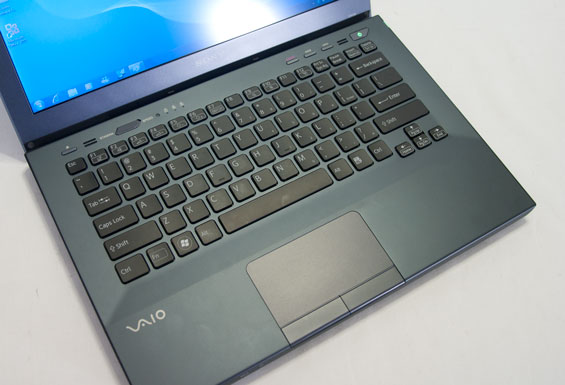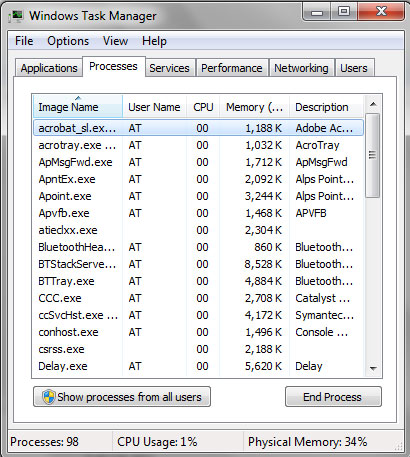Sony VAIO S Series: All Day Consumer Computing
by Dustin Sklavos on September 9, 2011 12:00 AM EST- Posted in
- Laptops
- AMD
- Intel
- Sony
- Sandy Bridge
- 6000M
- VAIO S
- Switchable Graphics
Good Computer, Too Much Bloat
Generally when I've handled these notebook reviews, I haven't gone into the software/bloatware that ships on them too much, if at all. Truth be told, bloatware (at least in my experience) isn't the cancer on the industry that it used to be. These days the worst you have to do is uninstall Norton and disable Bing bar and I'd be hard-pressed to find anyone who thinks that isn't a net win. But before we get to the part where Sony drops the ball with the VAIO S, we'll take a look at the good stuff.
As far as build quality and style go, the VAIO S is primo for a consumer laptop, no doubt about that. Sony uses a combination of aluminum, plastic, and magnesium alloy for the chassis that's extremely attractive, classy, and best of all, functional. There's just no gloss anywhere. And a weight of under four pounds for a powerful 13.3" notebook is really quite good; as far as heft and portability go, it's comparable to a netbook.

The lid appears to be made out of magnesium alloy, as it displays remarkably little flex when you try to twist the screen. From there, the inside surface is brushed aluminum with a recessed, backlit plastic keyboard. My only real complaint as far as the keyboard is concerned is the lack of dedicated document navigation keys, but given the overall thickness (or lack thereof) I'm inclined to let that slide.
Unfortunately the same can't be said for the touchpad. The tracking surface is something that I think is going to divide a lot of end users; some people will really like it, while some people (like me) are just going to find it doesn't feel particularly comfortable to use. Likewise, the mouse buttons feel stiff and require a bit more pressure than I'm used to. The touchpad and buttons probably shouldn't be a dealbreaker for anyone and most users will be able to get used to them, but this is one area where Sony can improve the design of the VAIO S.
Everything else (physically at least) is pretty stellar, though. Above the keyboard is the eject button for the optical drive, next to the "Stamina / Speed" switch. The "Stamina" mode switches off the AMD Radeon HD 6470M and relies on Intel's IGP, while automatically changing the power profile over to "power saver." On the other hand, the "Speed" mode enables the 6470M and switches the power profile over to "high performance." As I mentioned before, Sony appears to be using muxes to handle graphics switching instead of AMD's dynamic switching software solution, and the screen blinks a couple of times (takes about ten seconds) when switching between modes. Thankfully it doesn't require a reboot.
The VAIO S' battery is housed internally, but a single plate on the bottom of the notebook can be removed to swap it out along with changing the hard drive or adding memory to the single DIMM slot. Clearly the battery isn't designed to be hot-swappable, but it doesn't need to be either; there are grooves on the bottom of the notebook the extended sheet style battery latches into.

And then there's this (and then there's Maude?) I actually had my work cut out for me getting the VAIO S into stomping shape for testing, because the factory restored image has a punishing 100 processes running at the outset, which eventually shrinks down to a more reasonable...97? It's really bad. The bloat on the VAIO isn't just the usual bloatware, a tremendous amount of it is Sony's own pack-in crap. Between all of the junk software and the agonizingly slow 5400RPM hard drive, what should be a fairly agile little computer can actually be rendered nigh unusable. I actually had to do the factory restore after I'd started copying over my test suite; Windows Update running in the background was exactly enough to bring the whole system to a crawl, to the point where the mouse pointer lags hopelessly.
Just to put things in perspective: while I'm writing this review on my desktop, I have Photoshop CS5, Windows Live Mail (quiet you), WinAMP, Steam, Trillian, and Firefox open, along with antiviral software, Dropbox, and my UPS system software in the system tray. That brings me up to about 3.6GB of used memory...and 62 processes.
















70 Comments
View All Comments
hp79 - Friday, September 9, 2011 - link
But I'm returning it because there were several problems with it.First unit had a bad bezel, not aligned/glued properly, and the 500gb WD Blue Scorpio 5400rpm made a click noise every time when idle. Returned.
Second unit came with almost perfect bezel, and the hdd was a Hitachi, and was very satisfied. Then my Alps touchpad stopped working. When I place my hand on left palm rest, then it would work. One day later, it started working again. I decided not to keep it even though I had such a great deal.
The screen has a very narrow viewing angle. I think it's even worse than the Acer 11" $200 netbook I had. You can't keep the lid open all the way for long time because it blocks the vent. The lid doesn't open too much either, so you'll be using it with the lid close to almost all the way to get that perfect viewing angle.
I liked the laptop a lot if it weren't these problems. I had 8gb ram, and samsung 256gb ssd in it. It was blazing fast. AMD graphics did make a lot of noise though.
duploxxx - Friday, September 9, 2011 - link
dude how can the AMD graphics in this laptop create noise??? the heatpipe of the gpu is connected to the cpu with single fan. Seen few Vaio passing buy from friends all those fans are horrible.hp79 - Friday, September 9, 2011 - link
You know what I meant there. I forgot to put "Using " in the beginning of that sentence.Of course they are connected to a heat pipe, duh.
When using intel graphics, I never had any complaint about the noise because it was mostly quiet.
waldojim42 - Friday, September 9, 2011 - link
I never had a problem with the screen blocking the exhaust. But mine did die a very early death. How much fighting did you have to go through for a replacement? I ended up on the phone for many, many hours trying to understand their system. "We don't have authority to do that, customer relations does." Followed by "Nope, sorry, you have to talk to the San Diego tech department." Who never answered the phone...hp79 - Friday, September 9, 2011 - link
Sorry to hear your experience. I just had to speak with Microsoft support person who was handling my case. When I finally said I want to return it, she said she'll email me a prepaid return label. No hassle at all.waldojim42 - Sunday, September 11, 2011 - link
That is good to know, going through a third party may be the way to go from now on.icebox - Friday, September 9, 2011 - link
I got my wife a 13'' vaio one year ago as she travels a lot. We had exactly the same problem, slow system, hdd was writting all the time. I reseted twice, uninstall everything I could it was still dead slow.It finally annoyed us so much that I went and bought a seagate momentus xt (she has to much files for an ssd to be an option) and installed windows off a standard oem disk (I had to call Microsoft's hot line for the activation but they were helpful and it worked) and only installed the needed drivers and nothing more (jumpy launchers, media players, demos, trials be damned) It's working fine ever since
dingetje - Friday, September 9, 2011 - link
yep, 16:9 is useless for anything except watching moviesDustin Sklavos - Friday, September 9, 2011 - link
...except you can get it at 1600x900, which is a higher resolution than we ever got in 13" or 14" notebooks. I agree the native resolution is crappy (although reasonable for a 13" notebook), but how is 16:9 at 1600x900 worse than 16:10 at 1440x900?MobiusStrip - Saturday, September 17, 2011 - link
Why?